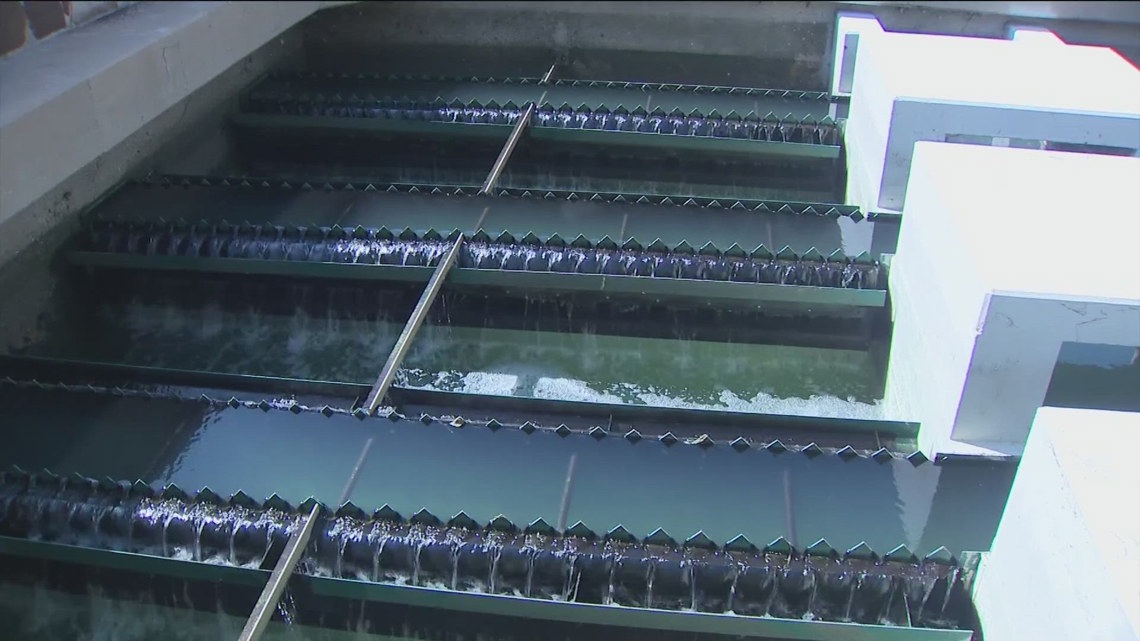
Senate Bill 7 aims to secure the state’s water supply amid its prolonged drought and expansive growth.
AUSTIN, Texas — On Wednesday, Gov. Greg Abbott signed a bill into law to strengthen water infrastructure in Texas.
Senate Bill 7 will invest billions into the state’s water infrastructure and the state’s future water supply over the next 20 years.
“We lose about 88 billion gallons of water a year because of broken, busted and aged pipes, so we have an across-the-board urgency to make sure that we address the water issue,” Abbott said.
Abbott named the issue as one of his seven emergency items for the legislative session, as Texas must figure out how to provide enough water amid a growing population and prolonged drought.
“In my district, people come to me often saying, ‘We’re concerned because we can see the level of the lake is low, and it should be after all these rains, it should be higher than it is,'” State Rep. Vicky Goodwin (D-Austin) said. “‘We’re concerned because there are so many new rooftops out in western Travis County, and yet the lake level is so low.’ It’s just a visual reminder of where we’re at with our water.”
The signing ceremony took place at Engineering Products Facility in Lubbock, which is where State Sen. Charles Perry (R-Lubbock), who has led the charge on water issues in the Texas Legislature, is from.
“It is a commitment that shows Texas is ready to meet the challenge of water,” Perry said.
House Speaker Dustin Burrows, who also lives in Lubbock, and State Rep. Cody Harris (R-Palestine) were also on-hand for the bill signing.
“Water doesn’t make it on primary mailers. It’s not one of those sexy things that we always hear about, but it is one of the most important issues for the state of Texas to dig our heels in, roll up our sleeves and try to solve this problem for future generations of Texans,” Harris said.
Burrows said this investment will not only help address the Texas water crisis but also help with the state’s growth.
“If they show up and they turn on that spigot and water doesn’t come out, those U-Hauls are going to go the absolute opposite direction,” he said. “It is one of the most important things that we have to do is to make sure we have this critical infrastructure, this water supply for the entire state of Texas.”
SB 7 would expand the list of water projects eligible for state money. It would also give greater oversight of the Texas Water Fund and measure performance and accountability.
SB 7 works jointly with House Joint Resolution 7, which would add $1 billion every year for the next 20 years to the Texas Water Fund. Half of the funding is allocated for water supply projects, such as repairing old or aging pipes and infrastructure, and the other half can be used based on the discretion of the Texas Water Development Board.
“We’re gonna make sure that we’re gonna be providing new sources of water to keep these cities, farms, ranches and businesses more robust than they are today,” Abbott said.
Since it would change the Texas Constitution for the Texas Water Fund to receive a $1 billion annual boost, voters would need to approve a constitutional amendment in November. It would give a total of $20 billion between 2027 and 2047 to secure the water supply.
The funding will be allocated to various projects, including desalination, the repair of old water infrastructure, conservation efforts and flood mitigation initiatives.
Goodwin expressed concern about the Oak Hill neighborhood in Austin, which she said had chronic water supply failures and old pipes that need to be addressed.
“In all of our districts, we have some private, small private water companies that provide water for neighborhoods that are experiencing leaky pipes, are experiencing aging infrastructure,” Goodwin said. “I wanted to make sure that we were putting some money into addressing leaky pipes and the need for new water systems, not just new water like desal and piping it from one part of the state to the other.”
She said it is a step in the right direction toward addressing the issue of leaky pipes.
“I think it’s still a challenge for particularly the small private water companies to access the money that they need to make repairs, but I’m hopeful that the Texas Water Development Board will make sure that the money is distributed throughout the state to address these issues,” Goodwin said.
A 2022 study by the Texas Water Development Board pointed to concerns over a possible future water shortage in Texas. That report estimated that more than 50 million people would be living in Texas by 2070, and water shortages alone could result in the loss of 1.4 million jobs and $92 billion in Gross Domestic Product (GDP). The 2022 state water plan also projected that the state’s municipal demands will surpass current water supplies in 2030.
Concerns have also been raised about the construction of large projects, including AI data centers, which will put even more strain on the state’s water supply. A report from Environment Texas details how one data center can consume up to 5 million gallons a day by cooling off hundreds or thousands of computers that quickly heat up.
According to Austin Water, the average water use per person in Austin is 131 gallons a day, or about twice the volume of a bathtub.
According to Texas 2036, the state will need nearly $154 billion by 2050 for water infrastructure, including $59 billion for water supply projects, $74 billion for addressing leaky pipes and infrastructure maintenance and $21 billion to repair broken wastewater systems.
“I think it’s a good step in the right direction. I think that we’ll have to do more in future sessions, but we’re lagging a little behind in the planning and preparing for the water development that we need,” Goodwin said. “I think that as we understand what the cost of some of these projects will be, then we’ll have a better idea of what money we need to put into it. Hopefully, in future years, we’ll be able to do that.”
Goodwin said the state should look to projects that have been successful, such as aquifer storage and recovery in San Antonio, where water is stored underground during heavy rain and then replenished into an aquifer that can be drawn out later.
“We should be not just building new water with the diesel plants, but also looking at how we can reuse, recycle water with HVAC condensation being reused in buildings and other ways that we can conserve and make sure that we’re utilizing our water sources in the smartest way possible,” Goodwin said.
SB 7 would also expand the types of water projects eligible for state funding and prioritize financial assistance for wastewater treatment projects in small communities with a population of less than 150,000.
“Because there are economies of scales, there are many communities that will never meet their water needs because of a low taxing jurisdiction, but anchored to a bigger one, they share that cost, and they also can develop a larger supply opportunity that would never have been available,” Sen. Perry said. “There are adequate supply opportunities to justify the investment that when you combined a regional approach will be more accessible, more obtainable, and more affordable.”
